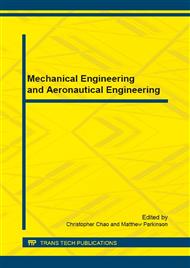[1]
R. Stoney, T. Pullen, B. Aldwell, et al. Observations of surface acoustic wave strain and resistive strain measurements on broaching tools for process monitoring[J]. Procedia CIRP, 2014, 14: 66-71.
DOI: 10.1016/j.procir.2014.03.024
Google Scholar
[2]
M. Cosmin. Strength analysis methods of circular pull broach cogs. [J]. Revista Fiabilitate si Durabilitate, 2010, 2(6): 73-78.
Google Scholar
[3]
Y.L. Zhang, W.Y. Chen. Finite Element Modeling of the Broaching Process of Inconel718, Materials Science Forum; 2012, Vols. 697-698.
DOI: 10.4028/www.scientific.net/msf.697-698.39
Google Scholar
[4]
V. Schulze, N. Boev, F. Zanger. Simulation of metal cutting process with variable cutting thickness during broaching. 5th CIRP Conference on High Perfor-mance Cutting 2012, 4. 6. 2012-6. 6. 2012, Zürich, Schweiz, Procedia CIRP 1, 454-459.
DOI: 10.1016/j.procir.2012.04.078
Google Scholar
[5]
W.R. Terry, R. Karn, Y.J. Huang. Concurrent tool and production system design for a surface broach cutting tool: a knowledge-based systems approach[J]. International Journal of Production Research, 1992, 30(2): 219-240.
DOI: 10.1080/00207549208942891
Google Scholar
[6]
Anonymous. Adjustment-free toolholder designed for swiss-type rotary broaching[J]. Modern Machine Shop, 2008, 81(4): 304-305.
Google Scholar
[7]
I. Etsion. State of the art in laser surface texturing[J]. Journal of Tribology, 2005, 127(1): 248-253.
DOI: 10.1115/1.1828070
Google Scholar
[8]
A. Volchok, G. Halperin, I. Etsion. The effect of surface regular microtopography on fretting fatigue life[J]. Wear, 2002, 253(3-4): 509-515.
DOI: 10.1016/s0043-1648(02)00148-5
Google Scholar
[9]
J.G. Wang, S.H. Chen. Analysis of Koch surface texture design and Gao snow Tie air friction noise [J]. Journal of mechanical engineering, 2014, 07: 78-83.
Google Scholar
[10]
B.F. Yin, Z.T. Lu, S.J. Liu, et al. The surface texture of cylinder liner lubrication performance of theoretical and Experimental Research on [J]. Journal of mechanical engineering, 2012, 21: 91-96.
DOI: 10.3901/jme.2012.21.091
Google Scholar
[11]
S. Piotr. Grinding forces in regular surface texture generation[J]. International Journal of Machine Tools and Manufacture, 2007, 47(14): 2098-2110.
DOI: 10.1016/j.ijmachtools.2007.05.004
Google Scholar
[12]
Z.H. Jiang, L.L. Wang, L. Shi, et al. Wear of cemented carbide cutting tools cutting Ti6Al4V mechanism and characteristics of [J]. Journal of mechanical engineering, 2014, 01: 178-184.
DOI: 10.3901/jme.2014.01.178
Google Scholar
[13]
T. Obikawa, A. Kamio, H. Takaoka, et al. Micro-texture at the coated tool face for high performance cutting[J]. International Journal of Machine Tools and Manufacture, 2011, 51( 12) : 966-972.
DOI: 10.1016/j.ijmachtools.2011.08.013
Google Scholar
[14]
P. Koshy, J. Tovey. Performance of electrical discharge textured cutting tools[J]. CIRP Annals-Manufacturing Technology, 2011, 60( 1): 153-156.
DOI: 10.1016/j.cirp.2011.03.104
Google Scholar
[15]
W. L. Song, J. X. Deng, Z. J. Wang. Friction reduction mechanism of micro pool lubrication tool dry cutting process [J]. Tribology, 2009, 02: 103-108.
Google Scholar


